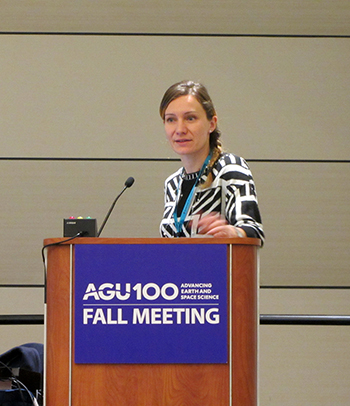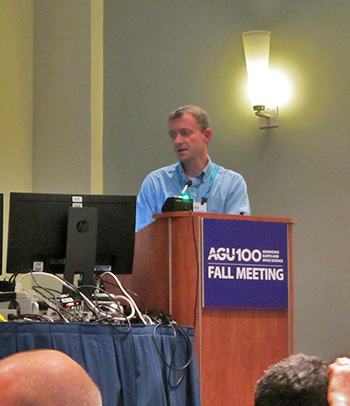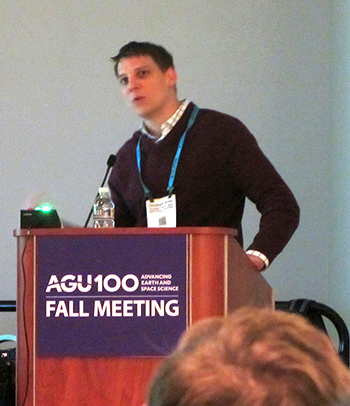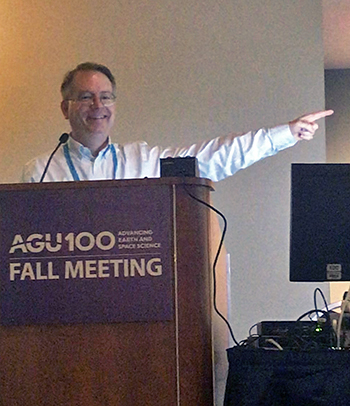NASA's GMAO Shows Strong Presence at AGU Fall 2018 in Washington, DC
01.25.2019

NASA’s Global Modeling and Assimilation Office (GMAO) had a strong participation in the 2018 American Geophysical Union (AGU) Fall Meeting held in Washington, DC, from December 10th through the 14th. GMAO scientists presented their science as part of speaker panels as well as led poster sessions on topics ranging from Arctic ice to Mt. Pinatubo. Below is a list of the GMAO presenters, along with the titles of their presentations and posters.
Please visit https://gmao.gsfc.nasa.gov/pubs/index.php?sel=posters&yr=2018 to view PDF versions of their AGU posters.




Oral Presentations:
Deepthi Achuthavarier – “Mechanisms and predictability of the MJO teleconnection signals in the NASA GEOS-5 subseasonal reforecasts”
Lauren Andrews – “The role of atmospheric teleconnections and local forcings of Greenland Ice Sheet surface mass loss”
Michael Bosilovich – “Development of Gridded Innovations and Observations supplement to MERRA-2” and “WCRP Task team for the Intercomparison of ReAnalyses (TIRA): Motivation and Progress”
Abhishek Chatterjee – “Future of the North American Carbon Cycle”
Mohar Chattopadhyay – “On the usage of re-calibrated AMSU-A data in NASA reanalysis”
Richard Cullather – “Recent Greenland and Antarctic Ice Sheet accumulation in global atmospheric reanalyses”
Arlindo da Silva – “The Impact of Geostationary Aerosol Observations on the GEOS Aerosol Forecasting System”
Ron Errico – “The convergence of analysis produced by overlapping assimilation streams”
Manuela Girotto – “Estimation of Seasonal Snow Water Equivalent Using Landsat Observations”
Christoph Keller – “Air quality forecasts using the NASA GEOS composition model” and “The central role of air quality observations in NASA’s GEOS air quality forecasting model”
Emma Knowland –“ Application of NASA’s new global high-resolution air quality forecasts: Stratospheric intrusion-influenced ozone exceedance events in the USA”
Jana Kolassa – “The SMAP Level-4 ECO Project: Improving terrestrial flux estimates through coupled hydrology-vegetation data assimilation”
Randy Koster – “Flash Drought as Captured by Reanalysis Data: Disentangling the Contributions of Precipitation Deficit and Excess Energy” and “Spatial correlation structures in SMAP near-surface soil moisture: Application to the reconstruction of historical soil moisture datasets”
Eunjee Lee – “Relative contributions of land fluxes and atmospheric circulation patterns to spatio-temporal variations in atmospheric CO2”
Erica McGrath-Spangler – “Impact of assimilating AIRS cloud-cleared radiances on atmospheric dynamics and polar low representation at high latitudes”
Isaac Moradi – “Assimilation of all-weather microwave cloudy radiances using a novel Bayesian Monte Carlo Technique into NASA GEOS-5”
Tomohiro Oda – “The use of gridded fossil fuel carbon dioxide emissions inventory for climate mitigation applications: Errors, uncertainties, and current and future challenges”
Nikki Prive – “Observing System Simulation Experiments as tools for investigating the behavior of data assimilation systems”
Oreste Reale –“ Impact of assimilating cloud-cleared and adaptively thinned infrared hyperspectral data on tropical cyclones in a global data assimilation and forecast framework.”
Kris Wargan – “Multidecadal changes in lower stratospheric ozone: variability vs. trends”
Posters:
Nathan Arnold – “Impact of a cold pool parameterization on the diurnal cycle and intraseasonal variability in the GEOS AGCM”
Donifan Barahona – “Seasonal predictability of cloud droplet number concentration”
Virginie Buchard – “Assimilation of Aerosol Observations in the NASA GEOS model”
David Carvalho – “Evaluation and validation of NASA’s GMAO MERRA2 reanalysis surface winds”
Allie Collow – “The Influence of Prescribed Boundary Conditions on Near-Surface Temperature over the Arctic” and “The Use of MERRA-2 near surface meteorology to understand the behavior of observed planetary boundary layer heights over the US Great Plains”
Larry Coy – “Sub-seasonal Forecasting of the Stratospheric Wave Events, Sudden Stratospheric Warmings, and their Influence on the Troposphere”
Anton Darmenov – “Implementation of the University of Miami Wave model (UMWM) into the NASA/GMAO Goddard Earth Observing System Model (GEOS)”
Amin Dezfuli – “Recent rainfall decline in West Africa due to enhanced biomass burning and dust emission”
Hamideh Ebrahimi – “Impact Study of the Assimilation of Surface Sensitive Microwave Radiances in the GEOS”
Manuela Girotto – “Data Assimilation of Terrestrial Water Storage to Adjust Precipitation Fluxes”
Eric Hackert – “Impact of Satellite Sea Surface Salinity Observations on ENSO Predictions from the GMAO S2S Forecast System”
Jianjun Jin – “Assimilating Satellite Microwave Imager TMI and AMSR2 Radiance Data in Future GEOS Reanalysis”
Young-Kwon Lim – “NASA/GEOS model for sub-seasonal to seasonal predictions: The major teleconnections, tropical cyclone activity, and ENSO”
Andrea Molod – “The Impact on Seasonal Forecasts of GMAO's Higher Resolution Seasonal Prediction and Data Assimilation System”
Nikita Mukherjee – “Effects of the Mount Pinatubo eruption on the GEOS forecasting system”
Lesley Ott – “Toward integrated seasonal predictions of land and ocean carbon flux: lessons from the 2015-16 El Nino”
Aish Raman – “Sea state based estimation of white cap fraction: Implications for primary marine aerosol fluxes”
Rolf Reichle – “Water Balance in the SMAP Level-4 Soil Moisture Algorithm”
Emily Saunders – “Global Modeling Assessment of PM2.5 During Wildfires: Inferring the Impact of PM2.5 Exposure on Adverse Respiratory & Cardiovascular Conditions”
Siegfried Schubert – “Regional Replay: A Unique Reanalysis-Based Diagnostic Tool for Addressing Model Error”
Ehud Strobach – “Air-sea Interactions in a High-Resolution Ocean-atmosphere Simulation”
Brad Weir – “Improving GEOS atmospheric carbon dioxide simulations by calibrating CASA surface fluxes with an empirical sink”

